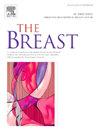在广泛淋巴结疾病的乳腺癌患者中省略腋窝淋巴结清扫,并使用MARI方案进行初步全身治疗
IF 5.7
2区 医学
Q1 OBSTETRICS & GYNECOLOGY
引用次数: 0
摘要
目的原发性全身治疗(PST)后腋窝淋巴结分期技术显示低假阴性率,刺激遗漏腋窝淋巴结清扫(ALND)。广泛淋巴结疾病的乳腺癌患者在应答引导腋窝治疗的研究中被低估。在这项研究中,我们报告了根据mari方案治疗的≥4个受累腋窝淋巴结的乳腺癌患者的肿瘤学结果。该前瞻性单臂研究纳入了2014年7月至2021年12月期间在FDG-PET/CT预pst上定义为≥4个累及腋窝淋巴结的广泛淋巴结疾病的乳腺癌患者。PST后,切除标记(MARI)淋巴结。MARI淋巴结(ypN0)病理完全缓解(pCR)的患者接受局部区域放射治疗(RT)。对于MARI淋巴结残留病变(ypN+)患者,行ALND后再行rt,主要终点为腋窝复发率。次要终点是侵袭性无病生存期(DFS)和总生存期(OS)。结果共登记218例患者,其中39%合并腋窝外淋巴结病变。中位(IQR)年龄为50(42-57)岁。PST后47%的患者(103/218)有ypN0,而53%的患者(115/218)有ypN+。中位随访44(26-62)个月后,ypN0组腋窝复发率为2.9% (n = 3), ypN +组为3.5% (n = 4)。ypN0患者5年侵袭性DFS和OS分别为89% (95% CI 83% - 96%)和95% (95% CI 91% - 99%)。结论广泛淋巴结累及且MARI淋巴结达到pCR的乳腺癌患者在PST后切除ALND与良好的5年肿瘤预后相关。本文章由计算机程序翻译,如有差异,请以英文原文为准。
Omitting axillary lymph node dissection in breast cancer patients with extensive nodal disease and excellent response to primary systemic therapy using the MARI protocol
Purpose
Axillary lymph node staging techniques after primary systemic therapy (PST) show low false negative rates, stimulating the omission of axillary lymph node dissection (ALND). Breast cancer patients with extensive nodal disease are underreported in studies on response-guided axillary treatment. In this study, we present the oncologic outcome of breast cancer patients with ≥4 involved axillary lymph nodes treated according to the MARI-protocol.
Methods
This prospective single arm registration study included breast cancer patients with extensive nodal disease defined as ≥4 involved axillary lymph nodes on FDG-PET/CT pre-PST between July 2014 and December 2021. After PST, the marked (MARI) lymph node was excised. Patients with a pathologic complete response (pCR) of the MARI node (ypN0) received locoregional radiation treatment (RT). In patients with residual disease of the MARI node (ypN+), ALND was performed followed by RT. Primary endpoint was axillary recurrence rate. Secondary endpoints were invasive disease-free survival (DFS) and overall survival (OS).
Results
In total, 218 patients were registered of which 39 % of patients also had extra-axillary nodal disease. Median (IQR) age was 50 (42–57) years. After PST 47 % of patients (103/218) had ypN0, whereas 53 % of patients (115/218) had ypN+. After a median follow up of 44 (26–62) months, axillary recurrence rate was 2.9 % (n = 3) in the ypN0 group and 3.5 % (n = 4) in the ypN + group. Five-year invasive DFS and OS were respectively 89 % (95 % CI 83 %–96 %) and 95 % (95 % CI 91 %–99 %) in ypN0 patients.
Conclusion
Omission of ALND after PST in breast cancer patients with extensive nodal involvement who achieve pCR of the MARI node is associated with excellent five-year oncologic outcome.
求助全文
通过发布文献求助,成功后即可免费获取论文全文。
去求助
来源期刊

Breast
医学-妇产科学
CiteScore
8.70
自引率
2.60%
发文量
165
审稿时长
59 days
期刊介绍:
The Breast is an international, multidisciplinary journal for researchers and clinicians, which focuses on translational and clinical research for the advancement of breast cancer prevention, diagnosis and treatment of all stages.
 求助内容:
求助内容: 应助结果提醒方式:
应助结果提醒方式:


